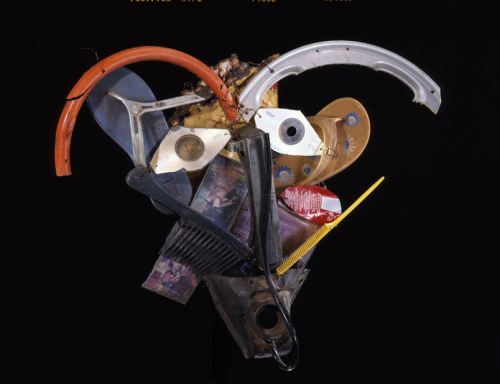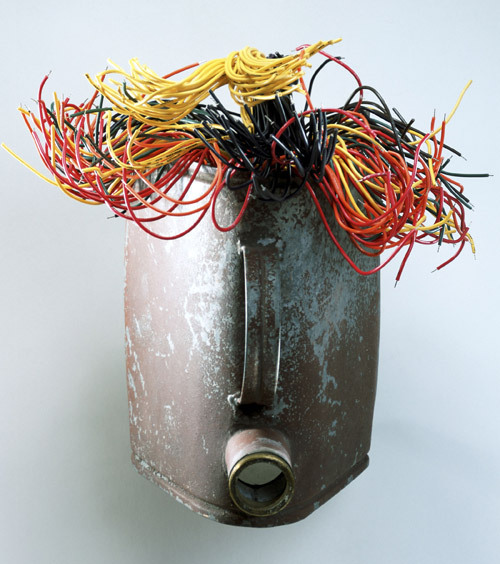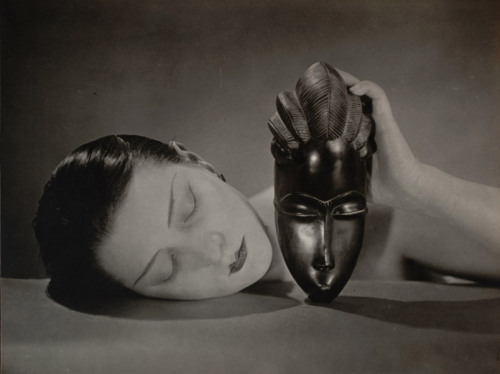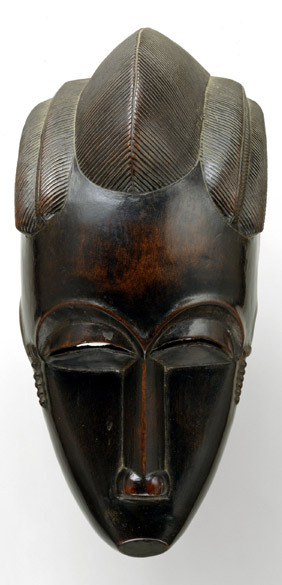Calixte Dakpogan (Beninese, born 1958), Heviosso, 2007, Metal, plastic (shoes and combs), CD, tape, H. x W. x D.: 74 x 55 x 28.5 cm), Courtesy CAAC - The Pigozzi Collection, Geneva, © Calixte Dakpogan.
Highly creative re-imaginings of the iconic form of the African mask comprise a unique installation at The Metropolitan Museum of Art. Featuring 20 works of art — 19 sculptures and one photograph — Reconfiguring an African Icon: Odes to the Mask by Modern and Contemporary Artists from Three Continents reflects on the enduring relevance of African masks as a source of inspiration for artists across cultures into the present.
Romuald Hazoumé (Beninese, born 1962), Internet, 1997, Metal can, electric cables, H. x W. x D.: 32.1 x 29.8 x 27.9 cm, Courtesy CAAC – The Pigozzi Collection, Geneva, © Romuald Hazoumé.
In many world cultures masks allow performers to adopt a wide range of characters and emotions. They can take on an endless variety of forms: human or animal; sacred or profane; dramatic or comedic. They are not meant to be experienced in isolation but rather as an integral component of celebrations, from the epic tributes to Dogon elders in Mali to popular holidays such as Halloween or the Day of the Dead and to the numerous Mardi Gras carnivals held throughout Europe and Latin America.
It is well established that African art forms, most notably the mask, were a source of inspiration for modern artists such as Pablo Picasso, André Derain, and Henri Matisse in the early twentieth century. The aesthetic of the African mask thus contributed to a redefinition of the Western visual lexicon. Considered especially alluring were its accessible reimagining of the human face and its aura of inscrutability.
Romuald Hazoumé (Beninese, born 1962), Ear Splitting, 1999, Plastic can, brush, speakers 42 x 22 x 16 cm, Courtesy CAAC – The Pigozzi Collection, Geneva, © Romuald Hazoumé.
This selection of works from Africa, Europe and the United States attests to the enduring relevance of the African mask in modern and contemporary art. The five artists represented here—Lynda Benglis, Willie Cole, Calixte Dakpogan, Romuald Hazoumé, and Man Ray—have all used the African mask as a catalyst for creative exploration. Their works reflect on a century of viewing the mask as a disembodied form—that is, as an art object in a museum removed from its original performative context. Informed by his or her respective individual experiences, each artist harnesses the transformative ability of unconventional materials to achieve unexpected reinterpretations of the idiom
African masks are often thought of as carved wooden artifacts, but they are an inherently complex and dynamic art form: to fully appreciate them, one must view them in motion, animated by costumes, dance, and music; the various media added to their surfaces are thought to imbue them with mystical powers; and the influence of foreign materials and techniques have led to a continuous redefinition of the genre. Such dynamism finds parallel expression in the work of these five artists, all of whom operate outside these traditions. Responding to the sheer physicality of the mask while alluding to its spiritual quality, each of their works pays tribute to the powerful legacy of the African mask and its infinite potential for reinvention.
Romuald Hazoumé (Beninese, born 1962), Internet, 1997, Metal can, electric cables, H. x W. x D.: 32.1 x 29.8 x 27.9 cm, Courtesy CAAC – The Pigozzi Collection, Geneva, © Romuald Hazoumé.
In many world cultures masks allow performers to adopt a wide range of characters and emotions. They can take on an endless variety of forms: human or animal; sacred or profane; dramatic or comedic. They are not meant to be experienced in isolation but rather as an integral component of celebrations, from the epic tributes to Dogon elders in Mali to popular holidays such as Halloween or the Day of the Dead and to the numerous Mardi Gras carnivals held throughout Europe and Latin America.
It is well established that African art forms, most notably the mask, were a source of inspiration for modern artists such as Pablo Picasso, André Derain, and Henri Matisse in the early twentieth century. The aesthetic of the African mask thus contributed to a redefinition of the Western visual lexicon. Considered especially alluring were its accessible reimagining of the human face and its aura of inscrutability.
Romuald Hazoumé (Beninese, born 1962), Ear Splitting, 1999, Plastic can, brush, speakers 42 x 22 x 16 cm, Courtesy CAAC – The Pigozzi Collection, Geneva, © Romuald Hazoumé.
This selection of works from Africa, Europe and the United States attests to the enduring relevance of the African mask in modern and contemporary art. The five artists represented here—Lynda Benglis, Willie Cole, Calixte Dakpogan, Romuald Hazoumé, and Man Ray—have all used the African mask as a catalyst for creative exploration. Their works reflect on a century of viewing the mask as a disembodied form—that is, as an art object in a museum removed from its original performative context. Informed by his or her respective individual experiences, each artist harnesses the transformative ability of unconventional materials to achieve unexpected reinterpretations of the idiom
African masks are often thought of as carved wooden artifacts, but they are an inherently complex and dynamic art form: to fully appreciate them, one must view them in motion, animated by costumes, dance, and music; the various media added to their surfaces are thought to imbue them with mystical powers; and the influence of foreign materials and techniques have led to a continuous redefinition of the genre. Such dynamism finds parallel expression in the work of these five artists, all of whom operate outside these traditions. Responding to the sheer physicality of the mask while alluding to its spiritual quality, each of their works pays tribute to the powerful legacy of the African mask and its infinite potential for reinvention.
Man Ray (American, 1890-1976), Noire et Blanche, 1926, Gelatin silver print, Private collection, New York, © 2011 Man Ray Trust / Artists Rights Society (ARS), NY / ADAGP, Paris.
Surveying Contemporary and Modern African Masks as Sculpture
Metropolitan Museum of Art
1000 Fifth Avenue at 82nd Street
212-535-7710
New York
Reconfiguring an African Icon: Odes to the Mask by Modern and Contemporary Artists from Three Continents
March 8-August 21, 2011
1000 Fifth Avenue at 82nd Street
212-535-7710
New York
Reconfiguring an African Icon: Odes to the Mask by Modern and Contemporary Artists from Three Continents
March 8-August 21, 2011
via





No comments:
Post a Comment